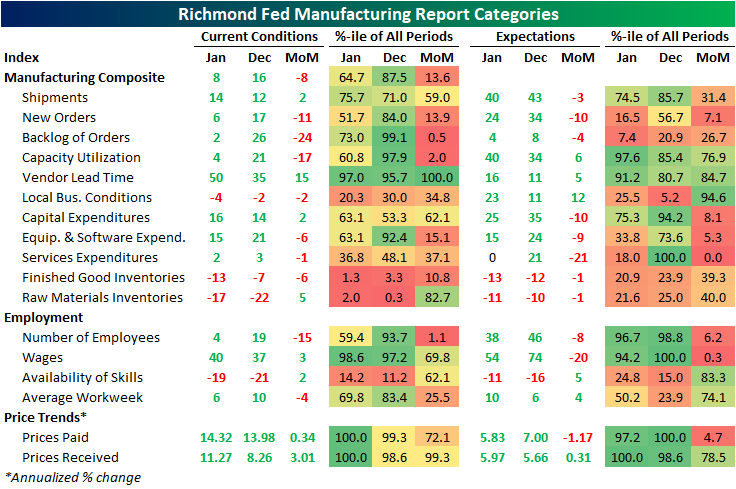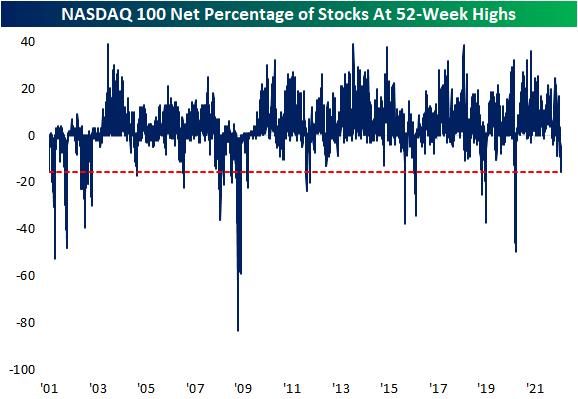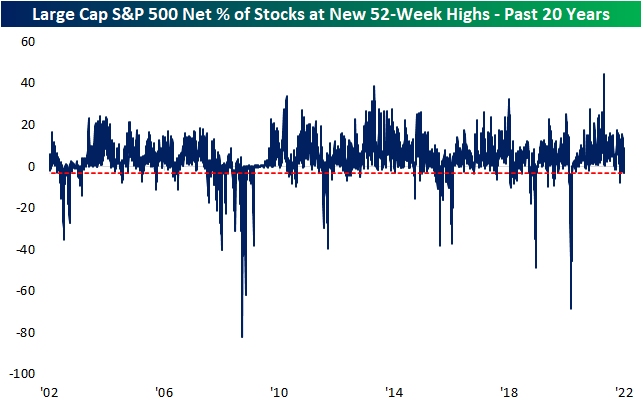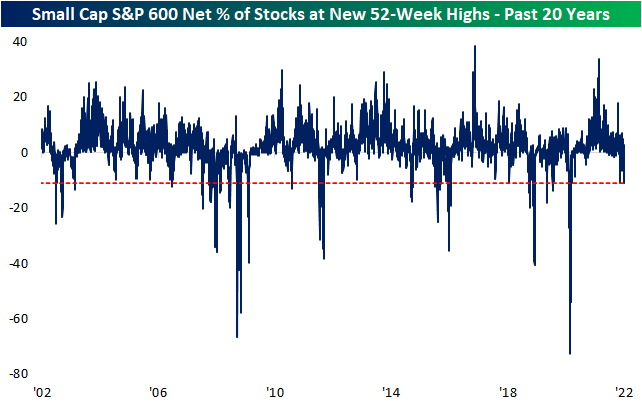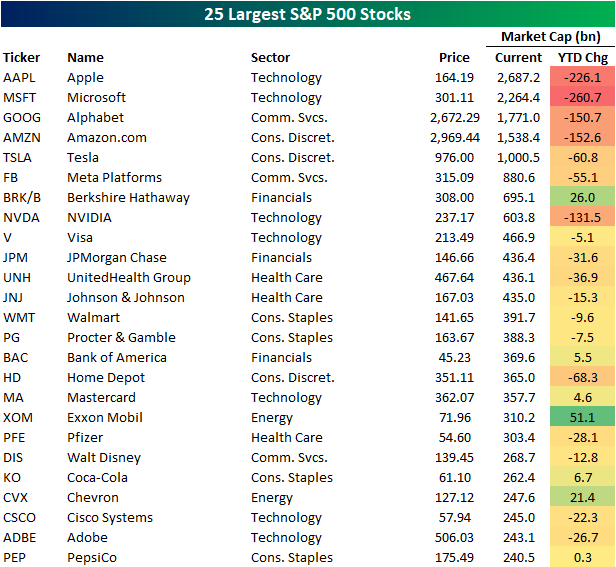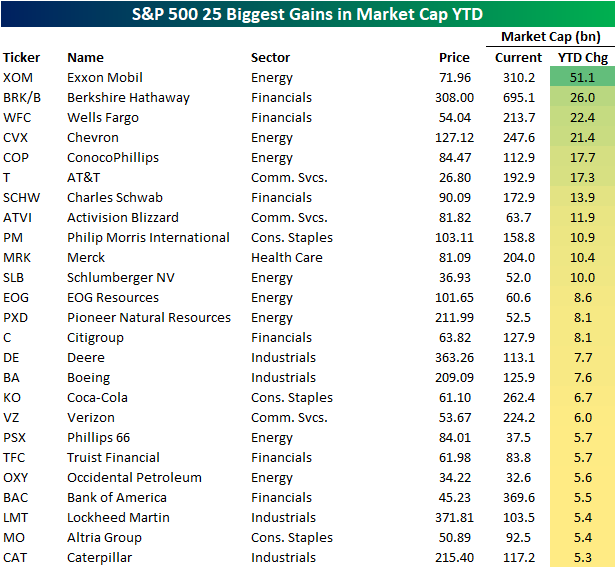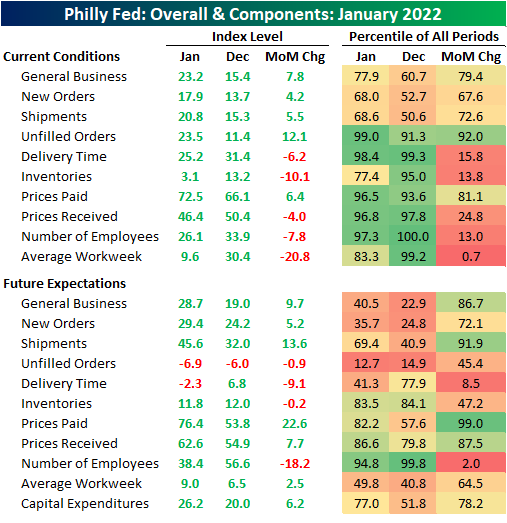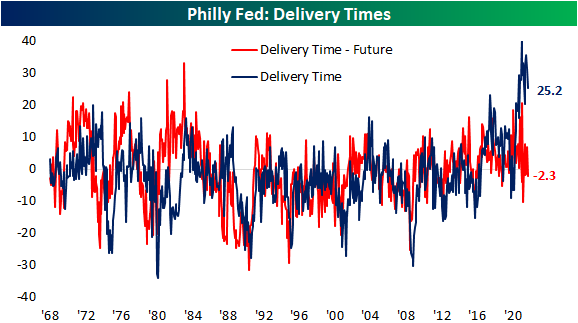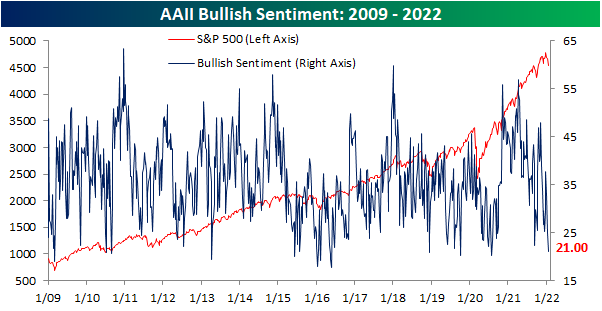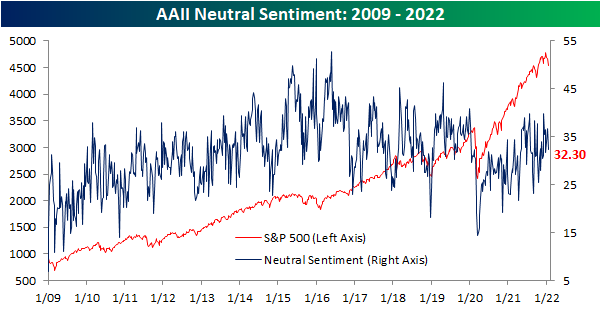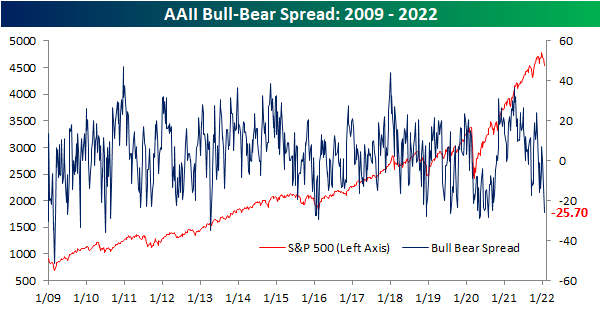Another Regional Fed Index Declines
The latest regional manufacturing index out of the Richmond Fed was released today covering the month of January. Whereas the Empire Fed reading plummeted and the Philly Fed bounced, the Richmond Fed’s index more went the way of the former. The index was cut in half falling 8 points to a level of 8. The current level continues to indicate expansionary activity but at a slower rate.
Breadth was weak in the report with most categories falling month over month across both current conditions and expectations. A handful of these were historically large declines too. For example, the decline in the Service Expenditure expectations index was the largest on record. Whereas last month many categories saw readings in the upper few percentiles of their historical ranges, this month most were more middling. But there are some exceptions as prices, vendor lead times, and wages all remain at or close to record highs.
Growth in new orders slowed significantly. The 11 point drop ranks in the 13th percentile of all monthly changes. The drop in backlogs was much more dramatic, though, with its 24 point decline ranking as the third-largest on record. Even though shipments accelerated, so too did vendor lead times with a record 15 point MoM increase. While there was that sharp increase, the index remains below the levels it sat at for most of last year.
Another area to experience a sharp decline in January was the index for the number of employees. The 15 point decline ranks as the sixth-largest on record indicating a rapid deceleration in hiring. The average workweek also declined meaning existing employees worked fewer hours. The index tracking the availability of skills continued to recover off of historic lows, but the current levels still point to a large talent gap. Wages also saw a minor bump this month, but expectations fell sharply with the month-over-month decline tied for the second-largest drop on record.
Not only were prices for labor higher but so too were prices paid and received. Both indices set new record highs well above any reading observed prior to the pandemic. Expectations moved in opposite directions though. Expectations for prices paid fell to a 5.83% annualized rate while expectations for prices received rose to a record high of 5.9%. Click here to view Bespoke’s premium membership options.
Semis Slide Below 200-Day
Breadth has been all-around bad recently. For example, as we highlighted in our Sector Snapshot, the 10-day advance-decline lines for the S&P 500 and the Tech sector are hovering close to the lowest levels since March 2020. We’re about as oversold as it gets from a short-term trading perspective. The semis are starting to break down too. Today, assuming it keeps up the pace of declines, the Philly SOX index is looking to close below its 200-DMA for the first time since the spring of 2020 as the uptrend off the COVID lows is on the ropes.
It has been well over a year since the Philadelphia Semiconductor index, or the SOX, has last closed below its 200-DMA. Assuming no historic jaw-dropping afternoon rally the likes of which haven’t been seen since…yesterday, the group is looking to end a 435 trading day streak of closes above its 200-DMA. Going back through the history of the index beginning in the mid-1990s, there have only been three streaks that have gone on for longer.
While it is not a particularly large sample size, given its reputation as a leading sector, we wanted to highlight the performance of the semis and the broad market after long streaks above the 200-DMA for semis come to an end. The only outright consistently negative performance in the following weeks and months was in 2000 during the dot com bust following the end of the streak in August 2000. Overall, median performance one week and one month later has been far stronger than the norm for the semis, Tech, and S&P 500. Going further out, things are more mixed relative to each index’s respective norm. For example, the semis are typically worse than normal 3 and 6 months out but have a larger than normal median performance one year out. Technology and the S&P 500 more broadly, meanwhile, have seen worse than normal performance 6 and 12 months out and inline performance 3 months later.
Triple Plays Taking A Snooze
A triple play is when a company reports better than expected results on the top and bottom line while also raising guidance. We consider these to be the gold standard for earnings, generally speaking, as they indicate a strong fundamental picture relative to expectations. Since the big banks kicked off earnings, though, triple plays have been hard to come by with only 5 of 92 total reports having been triple plays, and those five stocks have averaged a 1.61% decline on their earnings reaction days; slightly worse than the 1.56% average decline for all stocks reporting earnings so far.
Expanding the time frame, in the chart below we show the percentage of stocks reporting triple plays on a three-month rolling basis similar to the charts of beat rates in our Earnings Explorer tool. As shown, the pandemic has been a boon for triple plays as a result of a mix of pessimistic forecasts and strong rebounds. The percentage of stocks reporting triple plays over the past two years has been unlike anything in the history of our data going back to 2001. With that said, gravity has been hitting the triple play rate as it is heads into the current earnings season at the low end of the range since the fall of 2020.
With triple plays more frequent, they appeared to have lost their luster with weaker full-day changes on earnings than what was observed for most of the time prior to the pandemic. As the triple play rate has come down, stock price reactions have improved but are still on the weaker side relative to history. Currently, over the past three months the average triple play has rallied a little over 4% the day after earnings compared to 5.21% historically. Click here to view Bespoke’s premium membership options. You can monitor earnings triple plays on a daily basis with a Premium membership.
New Lows Expanding for the Nasdaq 100
In an earlier post, we highlighted weak breadth for the S&P 500 Tech sector which now has just 9.2% of stocks above their 50-day moving averages. Pivoting over to the tech-heavy NASDAQ 100, another look at bad breadth is the new low in the net percentage of stocks setting new 52-week highs versus 52-week lows. As shown below, a net 15.68% of the NASDAQ 100 is at 52-week lows today which is the lowest reading since the COVID Crash in March 2020. At the lows during the COVID Crash, nearly half of the index hit 52-week lows. There have only been a few other times going back to the beginning of the data in early 2001 in which this reading got this low. The current reading is only in the 2nd percentile of the historical range.
The chart below shows the distance from 52-week high for all of the Nasdaq 100’s members. There are currently only a dozen names that are currently within single-digit percentage points from their 52-week highs, while the average stock in the index is now 25.2% below its 52-week high. Click here to view Bespoke’s premium membership options.
Bye Bye Moving Averages
As of mid-day, the only sector that is not down over 2% is Consumer Staples, and even that defensive sector is down over 1.5%. As a result of the big declines across the market recently, there has been a notable drop in the percentage of stocks trading above their moving averages. Just a little over a week ago, over half of S&P 500 stocks traded above their 50-DMAs. Today, that reading is closer to a quarter of the index. As for the individual sectors, the readings for Consumer Discretionary, Real Estate, and Technology have fallen into single digits. One area that is holding up remarkably well is Energy with over 90% of its stocks above their 50-DMAs. Consumer Staples is the only other sector with more than three-quarters of its stocks above their 50-DMAs.
The readings with regards to the longer-term 200-DMA have held up better. 41% of the S&P 500 is above their 200-DMAs, but that too is down considerably versus the start of the year when three-quarters of the index was above their moving averages. Once again, Energy stands out with a far healthier reading at 90.5%, but that is actually the first sub-100% reading for Energy since January 6th. Real Estate, Financials, Consumer Staples, and Utilities have the next strongest readings. Click here to view Bespoke’s premium membership options.
Bespoke Brunch Reads: 1/23/22
Welcome to Bespoke Brunch Reads — a linkfest of the favorite things we read over the past week. The links are mostly market related, but there are some other interesting subjects covered as well. We hope you enjoy the food for thought as a supplement to the research we provide you during the week.
While you’re here, join Bespoke Premium with a 30-day free trial!
Commodities
Permian Basin: high oil price breathes new life into US shale by Myles McCormick (FT)
An on-the-ground report from the heart of US shale country and the good times that are rolling – for now – in West Texas as oil prices run far above break-evens for local producers. [Link; paywall]
Steelmaker CEO Warns North America Market a ‘Falling Knife’ by Joe Deaux (Bloomberg)
Canadian steelmaker Stelco is seeing a sharp drop in demand and building inventories amidst falling steel prices thanks to weak activity in construction and automaking industries and high production from mills [Link; soft paywall]
Government
Police in this tiny Alabama town suck drivers into legal ‘black hole’ by John Archibald (AL.com)
A horror story from a small suburb outside of Birmingham that has turned its police force into a revenue collection agency, complete with shocking over-spending by the department and invented charges designed to justify their budget. [Link]
The strange case of the casino, the Senate leader and the defense bill by Mark Satter (Roll Call)
An effort South Carolina’s Catawba Indian Nation to build a casino in North Carolina has led to strange Congressional bedfellows and a unique example of how the modern Congress functions: interest groups first, regular order out the window. [Link]
Sold To You
Robinhood and Democracy Promotion by Ranjan Roy (Margins)
A feature for Robinhood users that granted them exclusive access to IPOs has created massive losses for retail investors who opted in, blurring the lines between regular customer communications and marketing for the brokerage platform. [Link]
Renaissance Investor Exodus Nears $15 Billion Despite 2021 Gains by Hema Parmar (Bloomberg)
While Renaissance Technologies’ flagship fund delivered 20% returns in 2021, investors aren’t pleased thanks to underperformance versus the fund’s Medallion fund; billions have flowed out of the fund’s public vehicles over the past year. [Link; soft paywall]
Bonds
German Benchmark Bond Yield Briefly Turns Positive for First Time Since 2019 by Anna Hirtenstein (WSJ)
Increases in US Treasury bond yields have helped push up the yields on global government debt, and it actually costs Germany money to borrow in nominal terms now for the first time in almost two years. [Link; paywall]
Bond Market Forecasts Bad Economic News by Greg Ip (WSJ)
While we wouldn’t necessarily frame it as “bad news”, bond prices don’t reflect much worry over inflation or high policy rates needed to combat that inflation. [Link; paywall]
Puzzles
The Best Starting Words to Win at Wordle by Harry Guiness (Wired)
If you’ve gotten deep in to Wordle, you might want to brows this article which helps narrow down the field with some optimal guesses. [Link]
COVID
‘Nocebo’ effect blamed for two-thirds of COVID vaccine symptoms: Study by Hannah Sparks (NYP)
A study of vaccine side-effects report suggest that about two-thirds of side-effects from vaccines were psycho-somatic, given the level of side-effects reported by those who received placebo vaccines during clinical trials. [Link; auto-playing video]
This Week In Tech
‘It’s All Just Wild’: Tech Start-Ups Reach a New Peak of Froth by Erin Griffith (NYT)
More than 900 tech start-ups are unicorns, and investors are getting in to massive scrums over the right to buy in to the latest hot deal. [Link; soft paywall]
Sobriety
I Got Sober in the Pandemic. It Saved My Life. by Danielle Tcholakian (Jezebel)
A wonderful essay about finding community and escaping demons amidst the pandemic, with a little help from caring friends and none at all from booze. [Link]
Read Bespoke’s most actionable market research by joining Bespoke Premium today! Get started here.
Have a great weekend!
More Lows Than Highs
With more than half of the S&P 500 lower today, the index is once again looking to end the week in the red and with weak breadth. As a result of the consistent declines lately across the index, the net reading of the percentage of stocks at new 52-week highs versus lows is on pace to see the first negative reading since December 2nd.
Moving down through the spectrum of market caps, the readings on net new highs only get worse. The S&P 400 which is comprised of mid-cap names has an even lower reading of -6.23% of net new highs today. That is the lowest since November 30th, and prior to that, you would have to go back to the record low readings of March 2020 to find the last time that there were as wide of a margin between the number of stocks hitting new lows versus new highs.
Moving down again to the small cap S&P 600, once again the reading only gets worse. This index is seeing a double-digit negative reading. With a net 11.13% at new 52-week lows, it is the weakest reading since March 23, 2020 and is in the 5th percentile of readings going back to the start of the data in 1995. Click here to view Bespoke’s premium membership options.
Tech Sheds a Trillion
Earlier this week in our Sector Weightings report, we highlighted how the weight of the Technology sector remains well above that of any other sector, though, it did come off recent highs. In terms of market cap, the Tech sector is still valued at nearly $11 trillion. The next largest sectors are Health Care and Consumer Discretionary at a little over $5 trillion. Utilities is currently the only sector with a market cap under $1 trillion. Remember, back in April 2020, the S&P 1500 Energy sector’s market cap got down to just $701 billion!
Taking a look at the changes three weeks into the new year, Tech has already shed over a trillion dollars in market cap. Combined, Consumer Discretionary, Health Care, and Communication Services have also fallen by over a trillion dollars. Meanwhile, only Energy has seen its market cap increase.
As for the individual stocks of the S&P 500, there are currently five members with market caps above $1 trillion, and those five stocks have seen a combined drop in market cap of roughly $850 billion year to date. Apple (AAPL) and Microsoft (MSFT) are the biggest of these with market caps of $2.69 trillion and $2.65 trillion respectively, and as such, their declines year to date are the largest of any S&P 500 stock. Of the 25 largest S&P 500 members, only a handful have seen their market caps rise so far in 2022. Exxon Mobil (XOM) has seen the largest increase followed by Berkshire Hathaway (BRK/B) and Chevron (CVX).
In the table below, we show the 25 S&P 500 stocks that have seen their market caps rise the most this year. Not only does an Energy stock top the list, but across these 25 names, Energy stocks have the most representation. Financials also have a decent number making the list while not a single Consumer Discretionary or Tech name is to be found. Click here to view Bespoke’s premium membership options.
Philly Fed Redeems Empire Fed
Unlike the horrendous Empire Fed’s Manufacturing Report released on Monday, the neighboring Philly Fed’s survey saw somewhat more promising results. Rather than a dramatic drop, the headline number in the January report rose 7.8 points to 23.2. That is just barely in the upper quartile of readings historically and in the middle of the post-pandemic range.
While the main index was higher, breadth was fairly mixed. Again unlike the NY regional Fed survey that was released earlier this week, demand readings were broadly positive with New Orders, Shipments, and Unfilled Orders all higher. Employment, meanwhile, saw a substantial slowdown likely as a result of the Omicron wave.
Again, one of the main areas to have seen improvement was demand. While only in the 68th percentile of readings and well off the highs from just a couple of months ago, New Orders and Shipments were both higher. Unfilled Orders saw a much larger increase of 12.1 points to reach a 99th percentile reading. Inventories conversely saw a sharp decline of 10.1 points leaving that index at the lowest level since the negative readings in August.
The surge in unfilled orders and the big drop in inventories amidst only modest rises in shipments and new orders likely means that production took a step back in January, and a likely reason for that is a lack of a workforce due to COVID absentees. That is illustrated through Average Workweek which saw the fifth-largest decline on record as the index hit the lowest level since September 2020. Hiring also pulled back, though more modestly and it is coming off of a record high in December.
Although workers may not have been spending as much time at work, Delivery Times did manage to improve. That index remains well above any pre-pandemic reading meaning supply chains are still stressed, but the index did fall indicating some easing of the pressures. The expectations index even fell into negative territory indicating responding firms expect delivery times to begin to shorten in the future. Click here to view Bespoke’s premium membership options.
Sentiment Slammed
As could be expected with the NASDAQ meeting the technical definition of a correction and the S&P 500 continuing to pull back, sentiment has continued to take a dive with only 21% of respondents to the AAII sentiment survey reporting as bullish this week. That is the second week in a row in which less than a quarter of respondents reported as bullish. It is now also the lowest level since July 2020.
With such a large drop in bullish sentiment, there was a surge in bearish sentiment. Pessimism rose 8.4 percentage points week over week to 46.7%. That is the highest reading since September 2020.
While the decline was more modest, the increase in bearish sentiment also borrowed from those formerly reporting as neutral which fell from 36.8% to 32.3%. Unlike the other two readings, that does not set any sort of significant longer-term high or low, and the one-week change is also only the largest in three weeks.
Given bullish and bearish sentiment were the biggest movers and in opposite directions, the bull-bear spread has moved to a deeply negative reading. In the past two weeks, the bull-bear spread has dropped 25.2 points to -25.7 which is the lowest level—meaning bears outweigh bulls by the widest margin—since July 2020. Click here to view Bespoke’s premium membership options.

